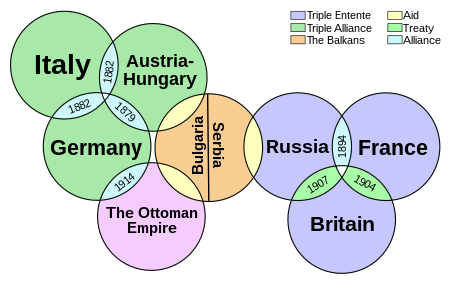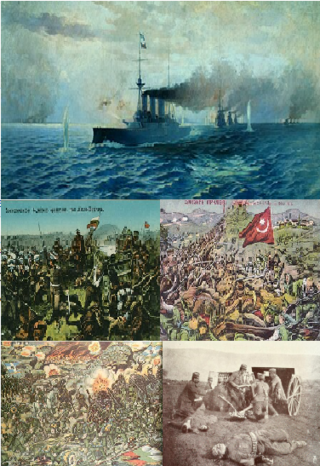
The Balkan Wars were a series of two conflicts that took place in the Balkan states in 1912 and 1913. In the First Balkan War, the four Balkan states of Greece, Serbia, Montenegro and Bulgaria declared war upon the Ottoman Empire and defeated it, in the process stripping the Ottomans of their European provinces, leaving only Eastern Thrace under the Ottoman Empire's control. In the Second Balkan War, Bulgaria fought against the other four original combatants of the first war. It also faced an attack from Romania from the north. The Ottoman Empire lost the bulk of its territory in Europe. Although not involved as a combatant, Austria-Hungary became relatively weaker as a much enlarged Serbia pushed for union of the South Slavic peoples. The war set the stage for the July crisis of 1914 and thus served as a prelude to the First World War.

The Central Powers, also known as the Central Empires, were one of the two main coalitions that fought in World War I (1914–1918). It consisted of Germany, Austria-Hungary, the Ottoman Empire, and Bulgaria; this was also known as the Quadruple Alliance.

Pan-Slavism was a movement which crystallized in the mid-19th century. It is a political ideology concerned with the advancement of integrity and unity for the Slavic people. Its main impact occurred in the Balkans, where non-Slavic empires had ruled the South Slavs for centuries. These were mainly the Byzantine Empire, Austria-Hungary, the Ottoman Empire, and Venice.

The Triple Alliance was a defensive military alliance between Germany, Austria-Hungary, and Italy. It was formed on 20 May 1882 and renewed periodically until it expired in 1915 during World War I. Germany and Austria-Hungary had been closely allied since 1879. Italy was looking for support against France shortly after it lost North African ambitions to the French. Each member promised mutual support in the event of an attack by any other great power. The treaty provided that Germany and Austria-Hungary were to assist Italy if it was attacked by France without provocation. In turn, Italy would assist Germany if attacked by France. In the event of a war between Austria-Hungary and Russia, Italy promised to remain neutral. The existence and membership of the treaty were well known, but its exact provisions were kept secret until 1919.

The League of the Balkans was a quadruple alliance formed by a series of bilateral treaties concluded in 1912 between the Eastern Orthodox kingdoms of Greece, Bulgaria, Serbia and Montenegro, and directed against the Ottoman Empire, which at the time still controlled much of Southeastern Europe.
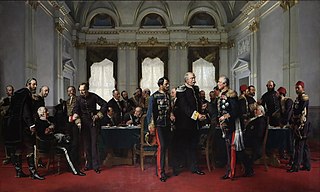
The Congress of Berlin was a diplomatic conference to reorganise the states in the Balkan Peninsula after the Russo-Turkish War of 1877–78, which had been won by Russia against the Ottoman Empire. Represented at the meeting were Europe's then six great powers: Russia, Great Britain, France, Austria-Hungary, Italy, and Germany; the Ottomans; and four Balkan states: Greece, Serbia, Romania and Montenegro. The congress concluded with the signing of the Treaty of Berlin, replacing the preliminary Treaty of San Stefano that had been signed three months earlier.

Under Tsar Nicholas II, the Russian Empire slowly industrialized while repressing opposition from the center and the far-left. During the 1890s Russia's industrial development led to a large increase in the size of the urban middle class and of the working class, which gave rise to a more dynamic political atmosphere. Because the state and foreigners owned much of Russia's industry, the Russian working class was comparatively stronger and the Russian bourgeoisie comparatively weaker than in the West.
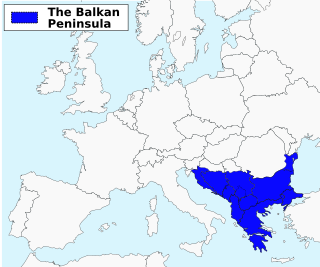
The Balkans and parts of this area are alternatively situated in Southeastern, Southern, Eastern Europe and Central Europe. The distinct identity and fragmentation of the Balkans owes much to its common and often turbulent history regarding centuries of Ottoman conquest and to its very mountainous geography.

Austro-Slavism or Austrian Slavism was a political concept and program aimed to solve problems of Slavic peoples in the Austrian Empire. It was most influential among Czech liberals around the middle of the 19th century. First proposed by Karel Havlíček Borovský in 1846, as an opposition to the concept of pan-Slavism, it was further developed into a complete political program by Czech politician František Palacký. Austroslavism also found some support in other Slavic nations in the Austrian Empire, especially the Poles, Slovenes, Croats and Slovaks.

The identification of the causes of World War I remains a debated issue. World War I began in the Balkans on July 28, 1914, and hostilities ended on November 11, 1918, leaving 17 million dead and 25 million wounded. Moreover, the Russian Civil War can in many ways be considered a continuation of World War I, as can various other conflicts in the direct aftermath of 1918.

The Bosnian Crisis, also known as the Annexation Crisis or the First Balkan Crisis, erupted on 5 October 1908 when Austria-Hungary announced the annexation of Bosnia and Herzegovina, territories formerly within the sovereignty of the Ottoman Empire but under Austro-Hungarian administration since 1878.

The July Crisis was a series of interrelated diplomatic and military escalations among the major powers of Europe in the summer of 1914, which led to the outbreak of World War I. The crisis began on 28 June 1914, when Gavrilo Princip, a Bosnian Serb nationalist, assassinated Archduke Franz Ferdinand, heir presumptive to the Austro-Hungarian throne, and his wife Sophie, Duchess of Hohenberg. A complex web of alliances, coupled with the miscalculations of numerous political and military leaders, resulted in an outbreak of hostilities amongst most of the major European nations by early August 1914.

Alois Leopold Johann Baptist Graf Lexa von Aehrenthal was diplomat from the Austro-Hungarian Empire. Biographer Solomon Wank says he exuded a strong monarchical-conservative outlook, loyalty to the Empire, and optimism regarding its ability to survive and flourish in the early 20th century. He is best known for promoting an energetic foreign policy in the Balkans, seeking cooperation with Russia and approval of Germany for actions that angered the South Slav element in the Balkans.

The Serbian campaign was a series of military expeditions launched in 1914 and 1915 by the Central Powers against the Kingdom of Serbia during the First World War.

The Bulgarian Crisis refers to a series of events in the Balkans between 1885 and 1888 that affected the balance of power between the Great Powers and the conflict between Austria-Hungary and the Russian Empire. It was one of several episodes in the continuing Balkan Crisis as vassal states struggled for independence from the Ottoman Empire but achieved a mosaic of nascent nation-states (Balkanisation). They featured unstable alliances that frequently led to war and eventually to the First World War.
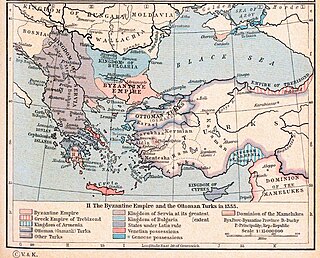
History of modern Serbia or modern history of Serbia covers the history of Serbia since national awakening in the early 19th century from the Ottoman Empire, then Yugoslavia, to the present day Republic of Serbia. The era follows the early modern history of Serbia.
The Budapest Convention was a secret agreement between Austria-Hungary and Russia in 1877 to agree on policies and the division of powers in Southeast Europe in the eventuality of war between Russia and the Ottoman Empire. The so-called Eastern Question, the division of the declining Ottoman Empire in the Balkans, was a priority of the European great powers in the nineteenth century. For Russia, obtaining assurances of Austro-Hungarian neutrality was also a priority.

Germany entered into World War I on August 1, 1914, when it declared war on Russia. In accordance with its war plan, it ignored Russia and moved first against France–declaring war on August 3 and sending its main armies through Belgium to capture Paris from the north. The German invasion of Belgium caused Britain to declare war on Germany on August 4. Most of the main parties were now at war. In October 1914, Turkey joined the war on Germany's side, becoming part of the Central Powers. Italy, which was allied with Germany and Austria-Hungary before World War I, was neutral in 1914 before switching to the Allied side in May 1915.
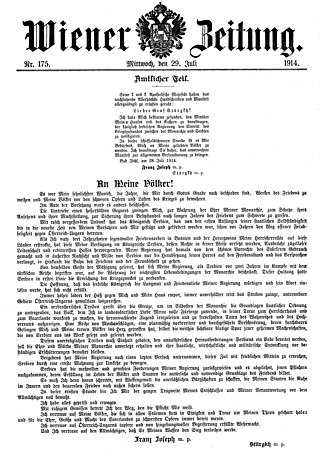
On 28 July 1914, Austria-Hungary declared war on Serbia. Within days, long-standing mobilization plans went into effect to initiate invasions or guard against them and Russia, France and Britain stood arrayed against Austria and Germany in what at the time was called the "Great War", and was later named "World War I" or the "First World War". Austria thought in terms of one small limited war involving just the two countries. It did not plan a wider war such as exploded in a matter of days.

The Russian Empire gradually entered World War I during the three days before July 28, 1914. This began with Austria-Hungary's declaration of war on Serbia, a Russian ally. Russia sent an ultimatum, via Saint Petersburg, to Vienna, warning Austria-Hungary not to attack Serbia. Following the invasion of Serbia, Russia began to mobilize the reserve army on the border of Austria-Hungary. Consequently, on July 31, Germany demanded Russian demobilization. There was no response, which resulted in the German declaration of war on Russia on the same day. Per its war plan, Germany disregarded Russia and moved first against France, declaring war on August 3. Germany sent its main armies through Belgium to surround Paris. The threat to Belgium caused Britain to declare war on Germany on August 4. The Ottoman Empire soon joined the Central Powers and fought Russia along their border.
